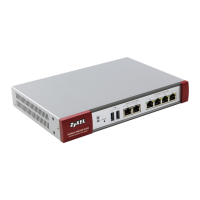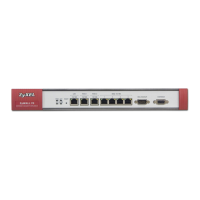Chapter 10 Routing
USG20(W)-VPN Series User’s Guide
231
10.2.1 Policy Route Edit Screen
Click Configuration > Network > Routing to open the Policy Route screen. Then click the Add
or Edit icon in the IPv4 Configuration or IPv6 Configuration section. The Add Policy Route or
Policy Route Edit screen opens. Use this screen to configure or edit a policy route. Both IPv4 and
IPv6 policy route have similar settings except the Address Translation (SNAT) settings.
Status This icon is lit when the entry is active, red when the next hop’s connection is down,
and dimmed when the entry is inactive.
User This is the name of the user (group) object from which the packets are sent. any
means all users.
Schedule This is the name of the schedule object. none means the route is active at all times if
enabled.
Incoming This is the interface on which the packets are received.
Source This is the name of the source IP address (group) object. any means all IP addresses.
Destination This is the name of the destination IP address (group) object. any means all IP
addresses.
DSCP Code This is the DSCP value of incoming packets to which this policy route applies.
any means all DSCP values or no DSCP marker.
default means traffic with a DSCP value of 0. This is usually best effort traffic
The “af” entries stand for Assured Forwarding. The number following the “af”
identifies one of four classes and one of three drop preferences. See Assured
Forwarding (AF) PHB for DiffServ on page 238 for more details.
Service This is the name of the service object. any means all services.
Source Port This is the name of a service object. The USG applies the policy route to the packets
sent from the corresponding service port. any means all service ports.
Next-Hop This is the next hop to which packets are directed. It helps forward packets to their
destinations and can be a router, VPN tunnel, outgoing interface or trunk.
DSCP Marking This is how the USG handles the DSCP value of the outgoing packets that match this
route. If this field displays a DSCP value, the USG applies that DSCP value to the
route’s outgoing packets.
preserve means the USG does not modify the DSCP value of the route’s outgoing
packets.
default means the USG sets the DSCP value of the route’s outgoing packets to 0.
The “af” choices stand for Assured Forwarding. The number following the “af”
identifies one of four classes and one of three drop preferences. See Assured
Forwarding (AF) PHB for DiffServ on page 238 for more details.
SNAT This is the source IP address that the route uses.
It displays none if the USG does not perform NAT for this route.
Apply Click Apply to save your changes back to the USG.
Reset Click Reset to return the screen to its last-saved settings.
Table 90 Configuration > Network > Routing > Policy Route (continued)
LABEL DESCRIPTION

